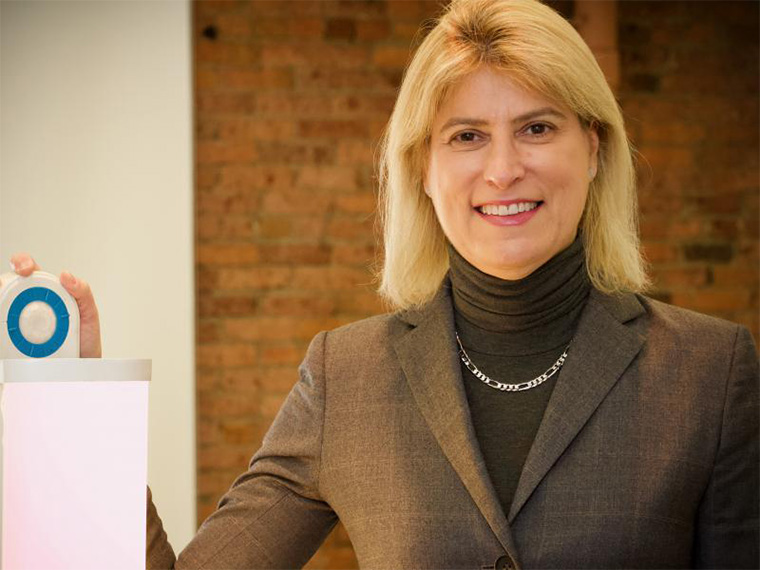With the support of a recent $3 million grant renewal from the National Institute on Aging (NIA), Mariana Figueiro is perfecting a treatment she developed for older adults with Alzheimer’s disease and related dementias that helps to regulate sleep and reduce symptoms of depression — and requires no drugs, only light.
With over 20 years of study and success in real-world settings, Figueiro, the director of the Lighting Research Center (LRC) at Rensselaer Polytechnic Institute, has demonstrated that providing light exposure of certain amounts and qualities throughout the day improves sleep patterns, sociability, and agitation while decreasing symptoms of depression.
“What we have proven is that light therapy is a non-pharmacological intervention that makes a significant difference in the overall health of older adults living with Alzheimer’s and dementia,” she said. “People we talk to are hoping to be able to reduce the number of pills these individuals must take every day. And we tend to forget how hard this disease is on caregivers. In addition to helping the patient, finding ways to help caregivers is very important.”
The NIA, which is a division of the National Institutes of Health (NIH), awarded Figueiro $3 million in 2010 to begin her research with elderly Alzheimer’s and dementia patients, followed by a first grant renewal in 2015 to continue her work. With this latest grant renewal, Figueiro and her team will fine-tune their approach to the dosage of light, working in long-term health care facilities to find the optimum brightness and duration that makes a quantifiable difference in a patient’s day-to-day life.
“It validates the research we’ve done in the past,” Figueiro said of the renewal, “and it’s a step forward on being able to embark on large clinical trials.”
Figueiro’s work has shown that exposure to bright, blue-hued light throughout the day signals to the body’s internal clock that it is daytime, promoting wakefulness. Then as evening approaches, dim, warmer orange-hued light tells the body that it’s time to rest. The flat, constant light found in most nursing homes just isn’t strong enough to properly regulate the body’s circadian rhythms.
“What’s happening with Alzheimer’s patients is that they are in constant biological darkness when it comes to their circadian systems,” she said. “They have enough light to see, but the lighting in nursing homes is typically too weak to contribute to good health. There are two ways to increase the amount of light. One is to increase the intensity, and the other is to tune it to a more bluish color, because we are more sensitive to that. We could do a combination or either one — that’s what we’ll be studying with this grant renewal.”
Figueiro envisions a future in which all rooms in assisted-living facilities and nursing homes have bright lights automatically providing patients with the light therapy she is perfecting. But the concepts being developed through her work are not solely applicable to populations in those settings. Whether a patient has a traumatic brain injury, cancer, or some other malady, or is simply a child or teenager still in the process of developing, her findings are consistent: Light is a key factor in establishing and maintaining the body’s circadian rhythms, which are critical to overall health.
“The science is solid,” she said. “The work with the Alzheimer’s patients is where we’re learning everything about how we can implement these solutions, but I think the future is to expand the range of applications by utilizing our research in a wide spectrum of populations.”
Her team at the LRC is already investigating other uses. For example, they are testing personal sensors and apps that can be used to prescribe optimum lighting schemes to maintain an internal routine. Beyond that, she sees the science behind light therapy applied to the general population as a kind of “light fitness.”
“It could be very similar to your personal trainer,” she said. “I think that’s where we’re going in the future. The key is understanding how light affects different individuals and different populations, and using our engineering and our technical background in order to develop solutions for people.”
This most recent grant renewal is just one source of support for Figueiro’s ongoing work. She will combine it with a five-year $1.5 million training grant she received from the NIA in 2017 that allows eight pre-doctoral engineering students to work at Rensselaer in collaboration with the Icahn School of Medicine at Mount Sinai in New York City each year in data translation and clinical applications as the university continues to push forward in the field of Alzheimer’s research.
Tagged with lightED, LRC, research